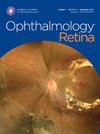美国接受抗血管内皮生长因子疗法和/或泛视网膜光凝治疗的增殖性糖尿病视网膜病变患者的随访损失。
IF 4.4
Q1 OPHTHALMOLOGY
引用次数: 0
摘要
目的确定美国接受抗血管内皮生长因子疗法和/或全视网膜光凝术(PRP)治疗的增殖性糖尿病视网膜病变(PDR)患者的随访丧失率。方法使用多变量逻辑回归模型估算几率比(ORs)和95%置信区间(CIs).主要结果测量随访丧失是指在最后一次治疗后的12个月内没有进行随访.结果在接受PDR治疗的患者中,11.7%(95% CI,11.5-12.0)的患者随访丧失.主要结果测量随访丧失是指在最后一次治疗后的12个月内没有进行随访.结果在接受PDR治疗的患者中,11.7%(95% CI,11.5-12.0)的患者随访丧失.主要结果测量随访丧失是指在最后一次治疗后的12个月内没有进行随访.在仅接受抗血管内皮生长因子治疗、仅接受PRP治疗以及抗血管内皮生长因子和PRP治疗的PDR患者中,LTFU率分别为12.3%(95% CI,11.8-12.7)、12.6%(95% CI,12.1-13.0)和10.8%(95% CI,10.4-11.1)。LTFU的风险因素包括黑人或非裔美国人种族/族裔(几率比[OR],1.26;95% CI,1.13-1.41;P <;0.001)、西班牙裔族裔(OR,1.28;95% CI,1.16-1.42;P <;0.001)、美国原住民/阿拉斯加原住民或夏威夷原住民/其他太平洋岛民种族/族裔(OR,2.69;95% CI,2.14-3.38;P <;0.001)和单侧疾病(OR,2.05;CI,1.88-2.23;P <;0.001)。基线视力为 20/50 至 20/200 的患者(OR,1.25;95% CI,1.15-1.36;P <;0.001)和视力差于 20/200 的患者(OR,1.22;95% CI,1.05-1.42;P = 0.01)LTFU 的几率高于基线视力为 20/40 或更好的患者。与私人保险相比,医疗保险付费服务(OR,0.71;95% CI,0.64-0.79;P <;0.001)和医疗保险管理(OR,0.66;95% CI,0.56-0.78;P <;0.001)的LTFU几率较低。与南部地区相比,中西部(OR,0.72;95% CI,0.64-0.81;P <;0.001)和西部(OR,0.83;95% CI,0.74-0.94;P = 0.003)接受治疗的患者LTFU几率较低。风险因素包括黑人或非裔美国人种族/族裔、西班牙裔、基线视力低于20/40、私人保险、南方地区和单侧疾病。本文章由计算机程序翻译,如有差异,请以英文原文为准。
Loss to Follow up in Patients with Proliferative Diabetic Retinopathy Treated with Anti-VEGF Therapy and/or Panretinal Photocoagulation in the United States
Purpose
To determine the rate of loss to follow up (LTFU) in patients with proliferative diabetic retinopathy (PDR) treated with anti-VEGF therapy and/or panretinal photocoagulation (PRP) in the United States.
Design
Retrospective cohort study using the national IRIS® (Intelligent Research in Sight) Registry data.
Subjects
A total of 73 595 eyes of 56 590 patients with PDR diagnosed between 2013 and 2015 and treated between 2013 and 2018.
Methods
Multivariable logistic regression models were used to estimate odds ratios (ORs) and 95% confidence intervals (CIs).
Main Outcome Measures
Loss to follow up was no follow up within 12 months from last treatment.
Results
For patient eyes treated for PDR, 11.7% (95% CI, 11.5–12.0) were LTFU. Among patients with PDR treated with anti-VEGF therapy alone, PRP alone, and anti-VEGF and PRP, the rates of LTFU were 12.3% (95% CI, 11.8–12.7), 12.6% (95% CI, 12.1–13.0), and 10.8% (95% CI, 10.4–11.1), respectively. Risk factors for LTFU include Black or African American race/ethnicity (odds ratio [OR], 1.26; 95% CI, 1.13–1.41; P < 0.001), Hispanic ethnicity (OR, 1.28; 95% CI, 1.16–1.42; P < 0.001), Native American/Alaska Native or Native Hawaiian/Other Pacific Islander race/ethnicity (OR, 2.69; 95% CI, 2.14–3.38; P < 0.001), and unilateral disease (OR, 2.05; CI, 1.88–2.23; P < 0.001). Odds for LTFU were higher with patients with baseline vision of 20/50 to 20/200 (OR, 1.25; 95% CI, 1.15–1.36; P < 0.001) and with vision worse than 20/200 (OR, 1.22; 95% CI, 1.05–1.42; P = 0.01) than for patient eyes with a baseline visual acuity of 20/40 or better. Odds for LTFU were lower for Medicare Fee-for-Service (OR, 0.71; 95% CI, 0.64–0.79; P < 0.001) and Medicare Managed (OR, 0.66; 95% CI, 0.56–0.78; P < 0.001) compared with private insurance. Odds for LTFU were lower for patients treated in the Midwest (OR, 0.72; 95% CI, 0.64–0.81; P < 0.001) and West (OR, 0.83; 95% CI, 0.74–0.94; P = 0.003) compared with in the South region.
Conclusions
The rate of LTFU is between 10% and 12% among patients with PDR who were treated with anti-VEGF injections and/or PRP. Risk factors include Black or African American race/ethnicity, Hispanic ethnicity, baseline vision worse than 20/40, private insurance, South region, and unilateral disease.
Financial Disclosure(s)
Proprietary or commercial disclosure may be found in the Footnotes and Disclosures at the end of this article.
求助全文
通过发布文献求助,成功后即可免费获取论文全文。
去求助

 求助内容:
求助内容: 应助结果提醒方式:
应助结果提醒方式:


